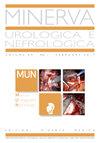Is urodynamic evaluation able to change and improve the management of women with idiopathic overactive bladder?
Q1 Medicine
引用次数: 6
Abstract
BACKGROUND For women with overactive bladder (OAB), current guidelines recommend the use of urodynamic studies (UDS) only in complicated cases. This study aimed to investigate whether UDS can also be helpful in uncomplicated cases. Specific aims of the study were (a): to evaluate objective benefit and subjective patient satisfaction with tailored treatment based on the UDS diagnosis compared to the outcomes of the pharmacological treatment only based on the symptoms; (b) to investigate the correlation between symptoms and UDS findings in women with uncomplicated idiopathic OAB symptoms; (c) to assess the ability of UDS to modify management decisions in these patients. METHODS Women presenting to our clinic with a history of uncomplicated OAB symptoms for the past three months or more, and who completed the International Consultation on Incontinence Questionnaire-Short Form (ICIQ-SF), were considered for this study. We proposed UDS to all participants. In women who accepted UDS (group 1), management decisions were made on the basis of urodynamic findings and post-treatment evaluation was scheduled at three months. The outcomes of treatments in these patients were compared to the results in women who did not accept UDS and who received pharmacological treatment symptoms-based (group 2). Objective outcomes were based on completion of a 3-day micturition diary. Subjective outcomes were captured using the Overactive Bladder Questionnaire Short Form (OABq-SF), the Patient Global Impression of Improvement (PGI-I) scale, and a patient satisfaction scale. RESULTS A total of 680 women were enrolled in the study; 478 underwent UDS and 202, at the contrary, declined UDS. In 53.6% of cases, UDS led to modification of the proposed management approach. At the 3- month follow-up, the overall patient satisfaction rate in group 1 and group 2 was 77 % and 65.8%, respectively (p=0.003). CONCLUSIONS we showed that OAB management tailored according to the UDS diagnosis results in higher subjective satisfaction if compared with a pharmacological treatment symptoms-based. Our study confirmed a lack of correlation between OAB symptoms and the urodynamically proven diagnosis of detrusor overactivity (DO). It also suggested that UDS can determine the underlying pathophysiology of every woman with OAB syndrome, whether complicated or uncomplicated, allowing treatment to be appropriately tailored with better results.尿动力学评估能改变和改善特发性膀胱过动症女性的治疗吗?
背景:对于膀胱过度活动(OAB)的女性,目前的指南建议仅在复杂病例中使用尿动力学研究(UDS)。本研究旨在探讨UDS是否也能对非复杂病例有所帮助。该研究的具体目的是(a):与仅基于症状的药物治疗结果相比,评估基于UDS诊断的量身定制治疗的客观获益和主观患者满意度;(b)调查无并发症特发性卵巢囊肿症状妇女的症状与UDS检查结果之间的相关性;(c)评估UDS改变这些患者管理决策的能力。方法:在过去3个月或更长时间内有无复杂尿失禁症状史并完成国际失禁问卷短表(ICIQ-SF)的女性被纳入本研究。我们向所有与会者提议UDS。在接受UDS的女性(第一组)中,根据尿动力学结果做出管理决策,并在三个月时安排治疗后评估。将这些患者的治疗结果与未接受UDS和接受基于症状的药物治疗的女性(2组)的治疗结果进行比较。客观结果基于完成3天排尿日记。主观结果采用膀胱过度活动问卷简表(OABq-SF)、患者整体改善印象(PGI-I)量表和患者满意度量表进行记录。结果共有680名女性入组;478例采用UDS, 202例采用UDS。在53.6%的案例中,UDS导致了拟议管理方法的修改。在3个月的随访中,1组和2组患者总体满意度分别为77%和65.8% (p=0.003)。结论与基于症状的药物治疗相比,根据UDS诊断量身定制的OAB管理可获得更高的主观满意度。我们的研究证实OAB症状与尿动力学证实的逼尿肌过度活动(DO)诊断之间缺乏相关性。该研究还表明,UDS可以确定每位OAB综合征女性的潜在病理生理,无论其复杂与否,从而使治疗得到更好的结果。
本文章由计算机程序翻译,如有差异,请以英文原文为准。
求助全文
约1分钟内获得全文
求助全文
来源期刊

Minerva Urologica E Nefrologica
UROLOGY & NEPHROLOGY-
CiteScore
5.50
自引率
0.00%
发文量
0
审稿时长
>12 weeks
期刊介绍:
The journal Minerva Urologica e Nefrologica publishes scientific papers on nephrology and urology. Manuscripts may be submitted in the form of Minerva opinion editorials, editorial comments, original articles, video illustrated articles, review articles and letters to the Editor.
 求助内容:
求助内容: 应助结果提醒方式:
应助结果提醒方式:


